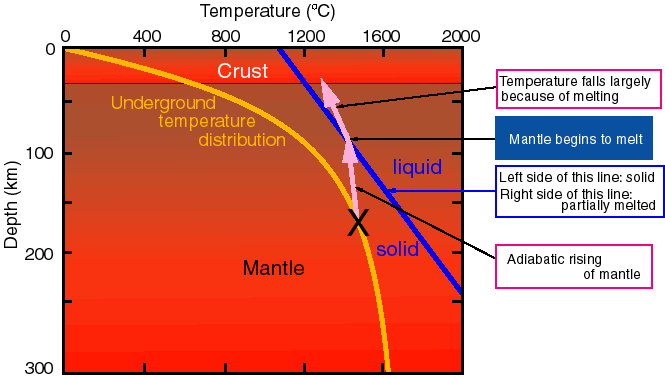 |
 The yellow line The yellow line
 in the figure below shows in the figure below shows
 the relation between the relation between
 the temperature the temperature
 and the depth under the ground. and the depth under the ground.
 (Since the pressure (Since the pressure
 depends on the depth, depends on the depth,
 we can consider we can consider
 it as the it as the
 relation between relation between
 the temperature and the the temperature and the
 pressure.) pressure.)

 The temperature of The temperature of
 the mantle is, in general, the mantle is, in general,
 lower than lower than
 its melting point. its melting point.
 Hence the mantle is solid Hence the mantle is solid
 usually. usually.

 If there is a hot mass of mantle If there is a hot mass of mantle
 (temporally denoted (temporally denoted
 by X in the figure), by X in the figure),
 the specific gravity of the mass is the specific gravity of the mass is
 slightly lighter slightly lighter
 than the surrounding part, than the surrounding part,
 and it gradually goes up and it gradually goes up
 (shown by the pink arrow in the figure). (shown by the pink arrow in the figure).

 Because the mantle Because the mantle
 is of low heat-conductivity is of low heat-conductivity
 (not easy to conduct heat), (not easy to conduct heat),
 the mass of mantle hardly the mass of mantle hardly
 cools while it rises up cools while it rises up
 (adiabatic rising). (adiabatic rising).
 Continuing to rise up, Continuing to rise up,
 it would finally begin to melt it would finally begin to melt
 due to decompression. due to decompression.
 This is nothing This is nothing
 but the magma generation. but the magma generation.
 Continuing to melt, Continuing to melt,
 the volume of magma increases, the volume of magma increases,
 and then the magma is and then the magma is
 separated from the mantle. separated from the mantle.
 Because the magma is Because the magma is
 light, it continues to go up. light, it continues to go up.
 Finally it Finally it
 reaches the boundary reaches the boundary
 between the mantle between the mantle
 and the crust, and and the crust, and
 piles up there. This is piles up there. This is
 just the magma chamber. just the magma chamber.

 The magma made thus is The magma made thus is
 basaltic magma basaltic magma
 of which composition is of which composition is
 the same as that of the same as that of
 the submarine crust the submarine crust
 or the lava flows on or the lava flows on
 the Hawaii Islands. the Hawaii Islands.

|

 Top of Part 5
Top of Part 5

 Previous p.
Previous p.

 Next page
Next page
 Magma is a silicate
Magma is a silicate
 melt produced by partial melting
melt produced by partial melting
 from mantle.
from mantle.

 In the depths of the earth,
In the depths of the earth,
 the mantle is very hot,
the mantle is very hot,
 but it is applied high pressure.
but it is applied high pressure.
 Thereby the mantle is
Thereby the mantle is
 in solid state.
in solid state.
 If this hot mantle comes up
If this hot mantle comes up
 near the surface of the earth,
near the surface of the earth,
 then the pressure goes down
then the pressure goes down
 and it would be
and it would be
 partially melted.
partially melted.
 This is nothing but the magma.
This is nothing but the magma.

